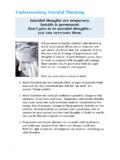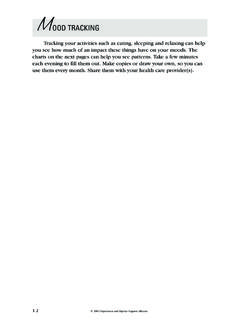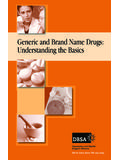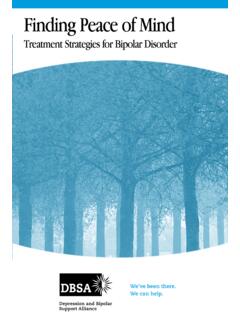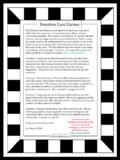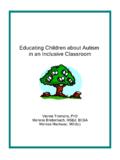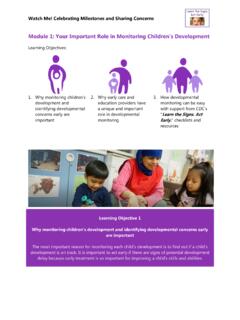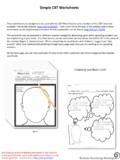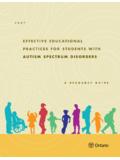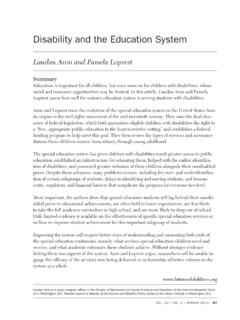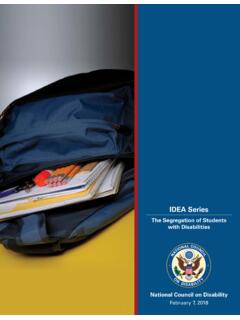Transcription of EDUCATING THE CHILD WITH
1 EDUCATING THE CHILD with BIPOLAR DISORDERC H I L D & A D O L E S C E N T B I P O L A R F O U N D AT I O NWhat is Pediatric Bipolar Disorder?Bipolar disorder is a biological brain disorder causing severe fluctuations in mood, energy, thinking and behavior. It was previously known as manic depression, as it causes moods to shift between mania and depression. children whose symptoms present differently than those of adults can experience severe and sudden mood changes many times a day. Symptoms of mania and depression can also occur simultaneously. Young people with this disorder are frequently anxious and have very low frustration least one million American children and teenagers struggle with bipolar disorder, most of them undiagnosed and untreated. children with bipolar disorder are at risk for school failure, substance abuse, and suicide. The lifetime mortality rate for bipolar disorder (from suicide) is higher than some childhood cancers.
2 Yet children who are stable and have the right support can thrive in school and develop satisfying peer children may not appear to be sad. Instead they may withdraw, not want to play, need more sleep than usual, display chronic irritability, or cry for no obvious reason. children may also talk of wishing to die and may need to be hospitalized for harm to themselves or others. Symptoms of mania may include elation, grandiose thinking, racing thoughts, pressured speech, hypersexuality, and decreased need for sleep. Since hyperactivity can be seen in both bipolar disorder and ADHD, a growing number of researchers believe that many children who are diagnosed with severe ADHD may actually have undiagnosed bipolar for no apparent reasonan expansive or irritable mood depression rapidly changing moods lasting a few minutes to a few days explosive, lengthy, and often destructive rages separation anxiety defiance of authority hyperactivity, agitation, and distractibility sleeping too little or too much night terrors strong and frequent cravings, often for carbohydrates and sweets excessive involvement in multiple projects and activities impaired judgment, impulsivity, racing thoughts, and pressure to keep talking dare devil behaviors inappropriate or precocious sexual behavior delusions and hallucinations grandiose belief in personal abilities that defy the laws of logic (ability to fly.)
3 Knows more than the teacher or principal)extreme irritability Commonly Seen Behaviors2 Recent brain imaging studies show biological differences in patients with bipolar disorder. The disorder affects learning in a number of ways, ranging from difficulties with sleep, energy, school attendance, concentration, executive function, and cognition. Side effects from medications can affect the CHILD s learning and energy. Moreover, while many of these children are uncommonly bright or creative, they often have co-occurring learning when moods are stable, the condition often causes cognitive deficits, including the ability to:Pay attentionRemember and recall informationThink critically, categorize, and organize informationEmploy problem-solving skillsQuickly coordinate eye-hand movements In addition, bipolar disorder can cause a CHILD to be at times impulsive, talkative, distractible, withdrawn, unmotivated, or difficult to engage.
4 Medications to manage the illness can cause cognitive dulling, sleepiness, slurring of speech, memory recall difficulties, and physical discomfort such as nausea and excessive all these challenges, a student with bipolar disorder can succeed in the classroom with the right supports and Bipolar Disorder AffectsCognition and LearningBipolar disorder is a chronic, lifetime condition that can be managed, but not cured, with medication and lifestyle changes. Because the symptoms wax and wane on their own, and children s bodies change as they grow, managing medication to ensure continued stability is a complex and ongoing For Teachinga CHILD with Bipolar DisorderThe teaching skills that make a classroom teacher successful with typical students are essential when working with children who have bipolar disorder: Flexibility to adapt assignments, curriculum and presentation style as to ignore minor negative behaviors, encourage positive behaviors, and provide positive behavioral choices.
5 Most important is the ability to stay calm and be a model of desired conflict management skills to resolve conflicts in a non-confrontational, non-combative, safe, and positive manner. Receptivity to change and to working collaboratively with the CHILD s parents, doctors, and other professionals to best meet the needs of the ability to laugh at oneself and at situations. Teachers who can laugh at their own mistakes, and bring fun and humor into the classroom reduce the level of stress that students for children describing how it feels to have a mood disorder. Available at for teens aboutmood disordersAvailable AccommodationsStudents with bipolar disorder benefit enormously from stress-reducing accommodations such as:Consistent scheduling that includes planned and unplanned breaksSeating with few distractions, providing buffer space and model childrenShortened assignments and homework focusing on quality, not quantityPrior notice of transitions or changes in routine minimizing surprisesA plan for unstructured time or lulls in the dayScheduling the student s most challenging tasks ata time of day when the CHILD is best able to perform (allowing for medication-related tiredness, hunger, etc.)
6 Since bipolar disorder affects all aspects of a CHILD s life, it takes a well-coordinated team of concerned adults to give the CHILD the best chance for a full and productive life. The team might include parents, teachers, special education specialists, a guidance counselor, an adjustment counselor or social worker, a school psychologist, an occupational therapist, a speech therapist, and the school nurse. The school team should feel comfortable consulting with the CHILD s psychiatrist and/or outside is critical to work closely with the CHILD s family to understand the symptoms and course of the illness. Parents should identify patterns in behavior that could signal a change in the illness, and help teachers brainstorm better ways of handling specific situations. Teachers and school personnel also need to know about changes in the CHILD s home life or medication in order to work around them constructively at school.
7 At times of transition, the current or previous year s teacher needs to work closely with the new teacher or team to smooth the way change is difficult for any CHILD , but even more difficult for the CHILD with a neurological Up to Help the Child5 Students with bipolar disorder face tough challenges navigating through the many pressures of a typical school day. Their neurologically-based mood disorder affects emotion, behavior, cognitive skills, and social interactions. These students are very vulnerable to stress that can easily overwhelm their coping skills. Therefore, it is paramount to their success in the classroom to reduce exposure to stressors and help them build coping skills that they will need throughout their lives. More than anything else, these children need structure and predictability to frame the day, provided by supportive and flexible teachers who calmly help them stay in control when any difficulties most important factor in these children s success is the way adults respond to and work with them.
8 The teachers who work best with these students are resourceful, caring, and calm, and know how to work positively with children s shifting moods and cognitive weaknesses. Praise, encouragement, and key words elicit positive behaviors, while negativity helps the CHILD spin out of control. Experts recommend some praise for all children at least once every 5 minutes, or 12 positive comments for every negative communication between home and school is essential. Contact should be frequent, timely, and focused on facts and solving problems (rather than blame). The school needs to inform parents regularly about how the student is performing. This can be done via a notebook that goes back and forth to school with the CHILD , or a daily chart or e-mail that records successes, progress, difficulties, and mood information. Parents can then reinforce and support the teacher and the CHILD . Parents can also spot trends in the CHILD s illness and respond before problems reach a crisis.
9 They should inform teachers of any unusual stressors at home and changes in medication. One of the challenges of working with these children is that even tried-and-true strategies may not work consistently due to the frequent mood shifts the students experience. Being prepared with a variety of approaches certainly increases a teacher s odds of dealing successfully with their students Teaching Strategies6In a manic mood, children may exhibit distractibility, increased energy, grandiose thinking, rapid speech, and a strong goal orientation. Help them direct all that energy productively with hands-on projects and increased activity. The CHILD will need help to set realistic goals. During lulls in the classroom, give the CHILD an OT break, send the CHILD on errands, or assign tasks involving motor activity, such as washing the board or moving items. Provide opportunities for the student to move around during class, work on computers, or use manipulatives and encourage him/her to get involved in other interactive activities.
10 You might even set up games and intervention strategy that allow the children to become more conscious of and better able to control their need for children are sad or depressed, exhibiting low energy, shorten their assignments and check in frequently to help them stay on track. Sometimes, simply asking what is wrong and how you can help is enough to get the CHILD back on track. children in a depressed state can find it extremely hard to wake up in time for school, particularly at certain times of the year. They should not be penalized for tardiness that is biologically based. Any talk of suicide must be taken seriously and reported to the CHILD s parents. You might not be able to discern clearly defined episodes of mania or depression because children with bipolar disorder often experience both states at once, producing chronic agitation and irritability. Defiance and aggression are probably the most challenging moods to manage.

